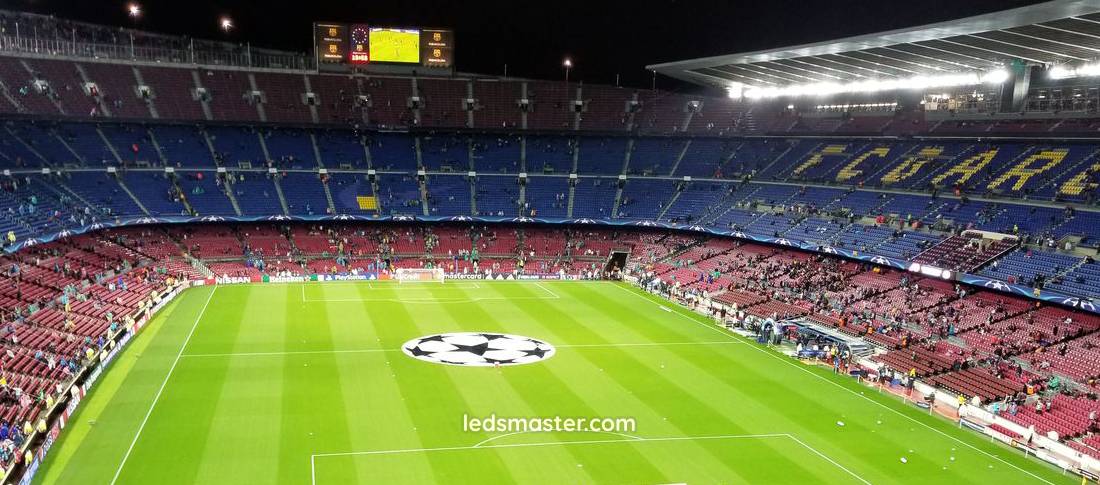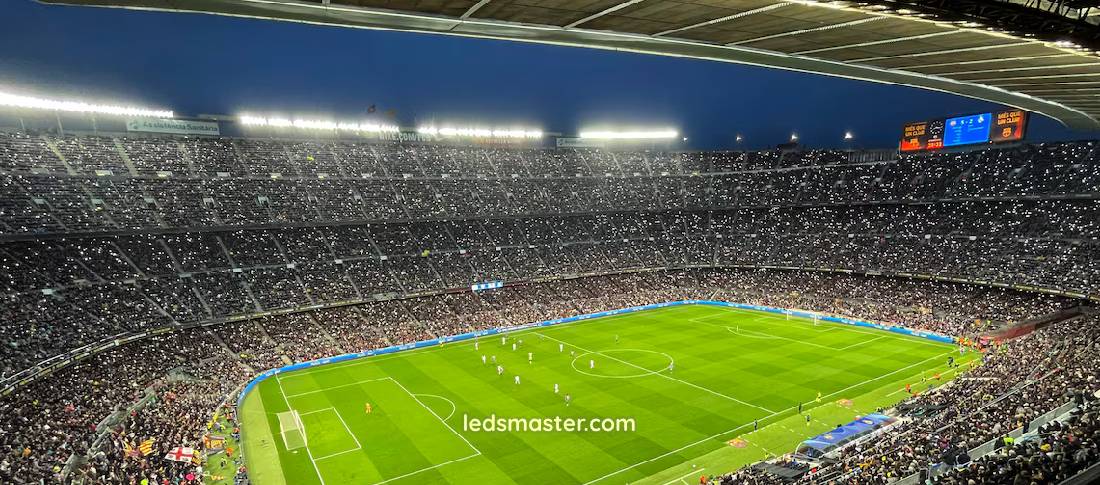Proper illumination not only ensures safety but also enhances the visual appeal of games and provides an optimal viewing experience. However, one common issue that can compromise stadium lighting is the presence of dark spots—areas where light levels are noticeably lower than in surrounding regions. These dark spots can create uneven playing conditions and diminish the overall ambiance of an event. This article explores the causes behind dark spots in stadium lighting and discusses remedies, with a particular focus on the advantages of LED lighting solutions.
Table of Contents
ToggleUnderstanding Dark Spots in Stadium Lighting
Dark spots in stadium lighting are areas where illumination is insufficient compared to other regions. Several factors contribute to the development of these dark spots, including fixture placement, obstructions, fixture quality, and light distribution. Understanding these causes is crucial for developing effective solutions to achieve uniform lighting.
Game Play and Fan Experience

Athlete Performance
Dark spots on the field can significantly impact athletes’ performance by creating inconsistent playing conditions. In sports such as soccer and football, where precise ball control and accurate positioning are essential, uneven lighting can hinder players’ ability to see and react to the ball effectively. When parts of the field are inadequately lit, players may struggle to judge the ball’s trajectory or their own positioning relative to other players, which can lead to mistakes and decreased performance. Uniform lighting across the field ensures that athletes can see the entire playing area clearly, allowing them to make better decisions, improve their accuracy, and enhance their overall performance. By eliminating dark spots, players can perform at their best without the added challenge of adjusting to variable lighting conditions.
Fan Engagement
The quality of lighting also plays a crucial role in the fan experience. Dark spots and uneven illumination can detract from the visual appeal of the game, leading to a less enjoyable experience for spectators. Fans expect to see every detail of the action clearly, and poor lighting can result in missed plays or diminished enjoyment of the event. High-quality, uniform lighting enhances the ambiance of the stadium, ensuring that all areas are brightly and consistently illuminated. This allows fans to follow the game with ease, catch every moment of excitement, and fully engage with the event. By improving lighting quality, stadiums can create a more immersive and satisfying experience for fans, contributing to their overall enjoyment and fostering a positive atmosphere in the venue.
Causes of Dark Spots
Inadequate Fixture Placement
One major cause of dark spots is inadequate fixture placement. In stadiums, lighting fixtures need to be strategically arranged to ensure even light distribution across the field. If fixtures are positioned too far apart or at incorrect angles, some areas may receive insufficient light, resulting in dark spots. Proper fixture placement is a meticulous process that involves a detailed analysis of the field and surrounding areas to determine the most effective positions for the lights. This includes accounting for the dimensions and shape of the field, the height of the fixtures, and the angle at which light is projected. Without careful planning, gaps in illumination can occur, leading to areas of the field or stands that are not adequately lit.
Obstructions in the Stadium
Obstructions in the stadium, such as scoreboards, overhead screens, and spectator stands, can also block light paths and create shadows. These obstructions prevent light from reaching certain areas, contributing to the formation of dark spots. The presence of such obstructions necessitates a thoughtful lighting design that takes into account their impact on light distribution. For example, scoreboards and screens should be positioned in a way that minimizes their interference with light paths. Additionally, the arrangement of seating and structural elements should be considered to avoid casting shadows on critical areas. Ensuring that the light paths are free from obstructions is essential for achieving uniform illumination and maximizing visibility across the stadium.
Quality of Lighting Fixtures
The quality of lighting fixtures is another critical factor influencing the occurrence of dark spots. Poor-quality fixtures may not deliver consistent light output, leading to uneven illumination and dark spots. These fixtures may suffer from issues such as inadequate lumen output, poor color rendering, or limited adjustability. Furthermore, maintenance issues, such as dirty lenses or malfunctioning bulbs, can diminish light intensity, further exacerbating the problem. High-quality fixtures are designed to provide consistent and reliable performance, with features that ensure even light distribution and minimize shadows. Regular maintenance, including cleaning lenses and replacing damaged components, is essential for maintaining optimal lighting conditions and preventing the formation of dark spots.

Inappropriate Light Distribution
Inappropriate light distribution can also result in dark spots. Fixtures with narrow beam angles may create concentrated pools of light, leaving surrounding areas inadequately lit. This is particularly problematic in large stadiums where even light coverage is crucial. Conversely, fixtures with excessively wide beam angles can cause light spill and reduced intensity in targeted areas, leading to uneven lighting and dark spots. Achieving the right balance in light distribution involves selecting fixtures with the appropriate beam angles and adjusting their positions to ensure that light is distributed evenly across the entire field and stands. Advanced lighting technologies, such as adjustable optics and beam-shaping lenses, can help fine-tune light distribution and address dark spots effectively.
Remedies for Dark Spots in Stadium Lighting
Optimizing Fixture Placement
Strategic fixture placement is essential for achieving uniform illumination and eliminating dark spots in stadiums. Effective placement starts with a thorough analysis of the field and surrounding areas. This analysis helps identify the optimal locations for lighting fixtures by considering factors such as the field’s dimensions, seating arrangement, and any potential obstructions. Advanced lighting design software can simulate light distribution and pinpoint areas where dark spots might occur before installation begins. This preemptive analysis allows designers to make data-driven decisions about fixture placement, ensuring a more accurate and effective lighting setup.
In addition to strategic placement, the use of fixtures with adjustable mounting options plays a critical role in fine-tuning light angles and positions. This flexibility is particularly valuable in stadiums where obstructions or structural elements, such as beams or scoreboards, can interfere with light distribution. Adjustable fixtures enable lighting designers to make precise adjustments to address specific dark spots and achieve the desired lighting levels, ensuring uniform coverage across the entire stadium.
Enhancing Fixture Quality
The quality of lighting fixtures is paramount in preventing dark spots and achieving high illumination standards. High-quality LED fixtures have become the preferred choice for stadium lighting due to their energy efficiency, long lifespan, and superior light quality. LEDs provide consistent and uniform illumination, which helps minimize the likelihood of dark spots. They also offer precise control over light distribution, allowing for fine-tuning to enhance coverage and reduce shadows.
Regular maintenance is crucial for maintaining the performance of lighting fixtures and ensuring that they continue to deliver optimal illumination. Maintenance tasks include cleaning lenses to remove dust and debris that can diminish light output, checking for any malfunctions, and replacing damaged components. Well-maintained fixtures are less likely to develop dark spots and will consistently deliver the light levels needed for effective stadium illumination.
Improving Light Distribution
Achieving even light distribution is crucial for eliminating dark spots and enhancing visibility in stadiums. LED fixtures with adjustable beam angles are instrumental in meeting specific lighting requirements and addressing dark spots. By selecting the appropriate beam angle, designers can tailor the light distribution to ensure even coverage and target illumination where it is most needed. This flexibility allows for precise adjustments to address any uneven lighting conditions that may arise.
Advanced optics in LED fixtures, including lenses and reflectors, also play a significant role in directing light more accurately and reducing dark spots. Customizable optics enable designers to achieve desired light patterns and ensure uniform coverage across the stadium. By utilizing high-quality optics, it is possible to enhance light distribution and minimize the occurrence of shadows and dark areas.
Utilizing Lighting Design Software
Lighting design software is an invaluable tool for addressing dark spots and optimizing stadium illumination. These software programs simulate light distribution and allow designers to model different fixture placements and settings to see their impact on overall lighting. By analyzing detailed simulations, designers can make informed decisions about fixture placement and configuration, ensuring that potential dark spots are identified and addressed before installation.
Some advanced lighting systems offer real-time monitoring and adjustments, which can further enhance the effectiveness of lighting design. These systems can detect variations in light intensity and automatically adjust fixture settings to maintain consistent illumination. Real-time adjustments help promptly address any emerging dark spots and ensure that lighting conditions remain uniform throughout events.
Implementing Upgraded Technologies
Upgrading to advanced lighting technologies can significantly improve illumination quality and reduce dark spots in stadiums. Dynamic lighting control systems, for instance, provide real-time adjustments based on the specific needs of an event. These systems can modify light levels and focus to address dark spots and enhance visibility as needed. For example, during a sports event, the lighting can be adjusted to highlight key areas of the field or adapt to changing conditions, ensuring optimal visibility for players and spectators.
Investing in high-performance LED solutions is another effective way to improve lighting quality and address dark spots. Modern LED fixtures offer higher lumen output, better color rendering, and more precise control over light distribution compared to traditional lighting technologies. By incorporating these advanced LED solutions, stadiums can achieve superior illumination and effectively mitigate dark spots, resulting in a more enjoyable and visually appealing experience for all.
Conclusion
Addressing dark spots in stadium lighting is crucial for enhancing both athlete performance and fan experience. By understanding the causes of uneven illumination, such as improper fixture placement and obstructions, and implementing remedies like optimizing fixture quality and using advanced LED technology, stadiums can ensure consistent, high-quality lighting. This not only improves the visibility and performance on the field but also enriches the viewing experience for fans, creating a more immersive and enjoyable event atmosphere. Investing in effective lighting solutions ultimately contributes to a more successful and engaging stadium environment.

